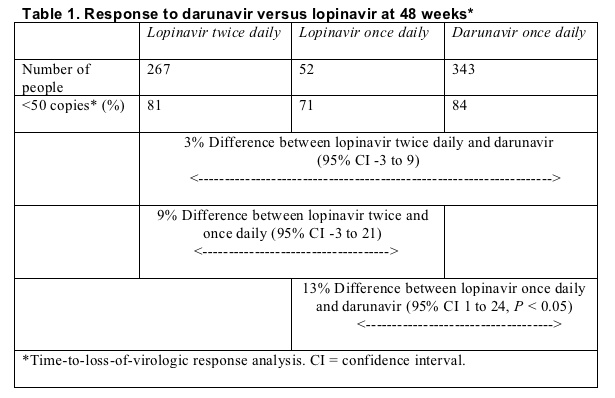 |
 |
 |
| |
ARTEMIS Study: Once-Daily Darunavir, Once-Daily Lopinavir, and Twice-Daily Lopinavir Compared
|
| |
| |
11th European AIDS Conference
October 24-27, 2007
Madrid
Mark Mascolini
In people starting antiretroviral therapy with a viral load topping 100,000 copies, once-daily darunavir/ritonavir looked stronger than once-daily lopinavir/ritonavir, according to 48 week results of the ARTEMIS trial [1]. But not everyone who saw the data spelled out at the European AIDS Conference considered the comparison fair.
ARTEMIS randomized 689 previously untreated people to 800/100 mg of darunavir once daily or to lopinavir/ritonavir, which physicians could prescribe at 400/100 mg twice daily or 800/200 mg once daily. Everyone also took fixed-dose tenofovir/emtricitabine (TDF/FTC) once daily.
After 48 weeks a time-to-loss-of-virologic response analysis determined that 84% assigned to darunavir and 78% assigned to lopinavir had a viral load below 50 copies. Statistically speaking, that meant once-daily darunavir is "not noninferior" to either once- or twice-daily lopinavir.
ARTEMIS investigators unveiled that result at a meeting a few weeks ago [2]. At the European conference Jan van Lunzen focused his analysis on potential response differences between the once- and twice-daily doses of lopinavir and the once-daily dose of darunavir--with special reference to pretreatment viral load. All 343 people randomized to darunavir/ritonavir took those protease inhibitors (PIs) at a once-daily dose of 800/100 mg. Of the people randomized to lopinavir/ritonavir, physicians prescribed it twice daily for 267 people (77%), once daily for 52 (15%), and once daily for 27 people (8%) who later switched to the twice-a-day dose. ARTEMIS statisticians excluded these 27 people from the virologic analyses van Lunzen went on to describe.
Similar proportions in each of the three dosage groups had a CD4 count under 200 (40% for darunavir, 41% for twice-daily lopinavir, and 37% for once-daily lopinavir), and similar proportions began therapy with a viral load above 100,000 copies (36%, 35%, and 35%). Median viral loads and CD4 counts were similar across the three groups.
After 48 weeks a slightly higher proportion of people taking darunavir than either lopinavir dose had a sub-50-copy viral load (Table 1). These differences were not statistically significant for the comparison between darunavir and twice-daily lopinavir, or for the comparison between twice- and once-daily lopinavir. But the difference between once-daily darunavir and once-daily lopinavir did reach statistical significance (P < 0.05).

Further analysis based on pretreatment viral load suggested that diminished response to once-daily lopinavir ritonavir among people starting with more than 100,000 copies accounted for the apparent superiority of once-daily darunavir over once-daily lopinavir (Table 2).

Defining virologic failure as a load above 50 copies, the ARTEMIS team counted 34 failures (10%) in the darunavir group, 31 (12%) in the twice-daily lopinavir group, and 10 (19%) in the once-daily lopinavir group. Among 10, 11, and 4 people in those three groups with available genotypes, no one taking darunavir or once-daily lopinavir had a PI-related mutation (according to the IAS-USA list) and 1 person taking twice-daily lopinavir had such PI mutations (A71T and V77I). Nucleoside mutations emerged in 1 person taking darunavir, 1 taking twice-daily lopinavir, and 1 taking once-daily lopinavir (all M184V or M184I/V).
Grade 2 to 4 diarrhea affected significantly more people taking lopinavir (8% twice daily and 17% once daily) than taking darunavir (4%) (P < 0.05). Significantly more people in the lopinavir groups also had grade 2 to 4 total cholesterol gains (23%) or triglyceride gains (38%) than those taking darunavir (13% and 3%) (P < 0.05). The higher ritonavir dose with lopinavir than with darunavir probably contributes to these differences.
Because trial clinicians with patients randomized to lopinavir could choose once- or twice-daily dosing, uneven numbers of people ended up in each treatment group (Tables 1 and 2). When investigators then ran a subanalysis of people with a starting viral load above or below 100,000 copies, they wound up with only 34 people in the once-daily lopinavir sub-100,000 group and only 18 in the once-daily lopinavir 100,000-plus group. Some attendees worried in the discussion after van Lunzen's talk that this imbalance makes those results tenuous.
Clinical researcher Graeme Moyle observed that failure to randomize people to once- or twice-daily lopinavir could result in a trial design flaw called "selection bias." In other words trial clinicians probably had specific reasons for picking once- or twice-daily lopinavir for each patient, and those reasons could bias results. For example, maybe some clinicians picked once-daily lopinavir for people they felt would have a problem with adherence. Then maybe some of those people did have a problem and missed doses. Van Lunzen did not have adherence or blood-level data that would confirm or disprove such speculation. He noted, though, that most people who took once-daily lopinavir were US residents because once-daily dosing is approved for treatment-naive people in the US. Even a US-versus-non-US imbalance could skew results because of different treatment practices in different countries.
Further analysis may ease these worries. In the meantime attendees who criticized the trial design probably agree that once-daily darunavir looks like a sturdy option for people starting antiretrovirals. But they want to see more data before they agree that it's significantly better than once-daily lopinavir. Meanwhile, a trial of once-daily 800/100-mg darunavir/ritonavir has begun for treatment-experienced people.
References
1. Clumeck N, van Lunzen J, Chiliade P, et al. ARTEMIS: efficacy and safety of lopinavir (BID vs QD) and darunavir (QD) in antiretroviral-naive patients. European AIDS Conference. October 24-27, 2007. Madrid. Abstract LBPS7/5.
2. DeJesus E, Ortiz R, Khanlou H, et al. Efficacy and safety of darunavir/ritonavir versus lopinavir/ritonavir in ARV treatment-naive HIV-1-infected patients at week 48: ARTEMIS (TMC114-C211). 47th Interscience Conference on Antimicrobial Agents and Chemotherapy. September 17-20, 2007. Chicago. Abstract H-718b.
|
| |
|
 |
 |
|
|